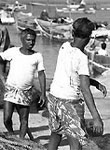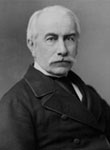Mumbai is India´s finance centre, the economic powerhouse of the nation, heart of the Hindi film industry and the industrial hub of everything from textiles to petrochemicals.
Mumbai is the glamour of Bollywood cinema, cricket on the maidans (open grassed areas), bhelpuri (a spicy sweet Mumbai snack) on the beach of Chowpatty, outstanding colonial architecture and red double-decker buses.
A walk down memory lane...
The Island city
 Koli fishermen
Koli fishermen
Mumbai was Bombay and this vast port and metropolis grew over three centuries from a collection of seven small, swampy islands into a giant magnet that each year still draws thousands of hopeful migrants seeking their fortune.The islands, originally inhabited by Koli fishermen, remained as they were for several centuries in the pre-Christian era. It was only in the following centuries, the development of important townships and ports took place on the mainland surrounding the islands.The place did witness some growth during the rule of several Hindu and Muslim dynasties, but a physical metamorphosis of the islands began only after the Portuguese takeover from the Muslim rulers of Gujarat in 1534.
The dowry
 Catherine of
Catherine of
Braganza
 King Charles II
King Charles II
In 1661, the islands were gifted by the Portuguese to King Charles II of England as part of his marriage dowry when he married Catherine of Braganza.
The British East India Company, which leased the islands from the Crown, foresaw the potential of the protected harbour located on the eastern seaboard of the largest of the seven islands and the natural bay on the west.In their endeavour to develop a prosperous trading post and port, the Company at first built a castle and fort. In the following decades a number of reclamation projects were undertaken to weld the seven islands together to provide space for the constantly growing population.
By the middle of the 19th century several industries were set up and most importantly the textile mills, and the population continued to multiply rapidly with immigrants seeking employment primarily in the railways, the docks and the mills.
The Commercial Boom. Restructuring Bombay. And more.
 Bartle Frere
Bartle Frere
In 1861, the American Civil war began and as a result of the blockade of the ports in the southern states of America; the Lancashire mills in England were unable to procure raw cotton from that country. The mills were forced to purchase cotton grown in western and central India from the Bombay markets and during the five-year period of the War, it was estimated that over £ 81 million pounds sterling came into the city. This resulted not only in a phenomenal commercial boom but also in a mania for speculation in the shares of companies that were primarily established to undertake extravagant schemes of reclamation.By 1864, there were 31 banks, 16 financial associations, 8 land companies, 16 press companies, 10 shipping companies, 20 insurance companies as against 10 in 1855, and 62 joint stock companies where none had existed in 1855!
Unfortunately, due to the cessation of the American Civil War in 1865, the commercial boom in Bombay collapsed and several companies went into liquidation. In the middle of the period of prosperity, Sir Bartle Frere, Governor of Bombay from 1862 to 1867, took the momentous decision to demolish the fort walls and restructure the town.The fort ramparts, gates and moat were removed completely and a new city arose on the space freed, with an array of imposing Gothic buildings constructed in the Fort area. By the end of the 19th century, Bombay evolved as the Urbs Prima in India, the leading city of India and the country's most important commercial, financial, trading and industrial centre and port. A severe plague epidemic in the 1890's resulted in many improvements being made to the city. With a number of new industries set up, the pressure on land grew further and building activity reached its peak in the 1930's when all available plots of land were built over.
Bombay and the freedom struggle
The Freedom Struggle received a tremendous impetus with Bombay taking the lead in almost every major political movement. Independence came in 1947, with refugees from Pakistan further adding to the population. In the latter half of the 20th century, Bombay quickly grew upwards in the form of high rises and outwards too, rapidly expanding into the northern suburbs and the mainland. Today the city's population is estimated at around 14 million.
Mumbai Fact File
"Three centuries ago, Mumbai was a collection of seven small, swampy islands"
"Mumbai's population is estimated at around 14 million today"
"Mumbai islands were gifted by the Portuguese to King Charles II of England as his marriage dowry"
"Mumbai's suburban rail systems carry a total of 2.2 billion passengers every year"
"As of June 2003, there are an incredible 982 villages in the Mumbai Metropolitan Region"
A number of books based on Mumbai can be found here
Last updated on 31/12/2016
|





















